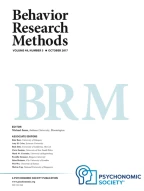Abstract
Tscope is a C/C11 programming library designed for programming experiments that run on Windows 2000/XP. It is intended for a public of experimental psychologists with moderate programming skills, who are accustomed to writing their own experimental programs for DOS but have not made the step to Windows-based programming yet. It provides molecular functions for graphics, sound, timing, randomization, and response registration. Together with ANSI-C standard library functions and the powerful C syntax, this set of functions gives the experimenter the opportunity to program virtually any experiment one can come up with. Tscope is completely based on free software, is distributed under the GNU General Public License, and is available at expsy.ugent.be/tscope. An integrated development environment for compiling and running Tscope programs is also freely available.
Article PDF
Similar content being viewed by others
Avoid common mistakes on your manuscript.
References
Brysbaert, M. (1991). Algorithms for randomness in the behavioral sciences: A tutorial.Behavior Research Methods, Instruments, & Computers,23, 45–60.
Chambers, C. D., &Brown, M. (2003). Timing accuracy under Microsoft Windows revealed through external chronometry.Behavior Research Methods, Instruments, & Computers,35, 96–108.
Cygnus Solutions (n.d.). Cygwin [Computer program]. For details on Cygwin, see www.cygwin.com/.
De Clercq, A., Crombez, G., Buysse, A., &Roeyers, H. (2003). A simple and sensitive method to measure timing accuracy.Behavior Research Methods, Instruments, & Computers,35, 109–115.
Dixon, P. (1991). The promise of object-oriented programming.Behavior Research Methods, Instruments, & Computers,23, 134–141.
Forster, K. L., &Forster, J. C. (2003). DMDX: A Windows display program with millisecond accuracy.Behavior Research Methods, Instruments, & Computers,35, 116–124.
Free Software Foundation, Inc. (1991). GNU General Public License. See www.gnu.org/copyleft/gpl.html.
Free Software Foundation, Inc. (n.d.). GNU Compiler Collection [Computer program]. Available at gcc.gnu.org/.
Hargreaves, S. (n.d.). Allegro Low Level Game Routines [Computer program]. For details on Allegro, see www.talula.demon.co.uk/allegro/.
Kang, I. (n.d.). Crimson Editor [Computer program]. For details on the Crimson Editor, see www.crimsoneditor.com/.
MacInnes, W. J., &Taylor, T. L. (2001). Millisecond timing on PCs and Macs.Behavior Research Methods, Instruments, & Computers,33, 174–178.
McKinney, C. J., MacCormac, E. R., &Welsh-Bohmer, K. A. (1999). Hardware and software for tachistoscopy: How to make accurate measurements on any PC utilizing the Microsoft Windows operating system.Behavior Research Methods, Instruments, & Computers,31, 129–136.
Myors, B. (1998). A simple graphical technique for assessing timer accuracy of computer systems.Behavior Research Methods, Instruments, & Computers,30, 454–456.
Myors, B. (1999). Timing accuracy of PC programs running under DOS and Windows.Behavior Research Methods, Instruments, & Computers,31, 322–328.
Norris, D. (1984). A computer-based programmable tachistoscope for nonprogrammers.Behavior Research Methods, Instruments, & Computers,16, 25–27.
Plant, R. R., Hammond, N., &Whitehouse, T. (2003). How choice of mouse may affect response timing in psychological studies.Behavior Research Methods, Instruments, & Computers,35, 276–284.
Psychology Software Tools, Inc. (n.d.). E-Prime 1.0 [Computer program]. For details on E-Prime for Windows, see www.pstnet.com/ e-prime/.
Shimizu, H. (2002). Measuring keyboard response delays by comparing keyboard and joystick inputs.Behavior Research Methods, Instruments, & Computers,34, 250–256.
Author information
Authors and Affiliations
Corresponding author
Additional information
This project was made possible by Grants 011D04503, 011D06102, and 10251101 from the Special Research Fund of Ghent University to the first, third, and fourth authors, respectively.
Rights and permissions
About this article
Cite this article
Stevens, M., Lammertyn, J., Verbruggen, F. et al. Tscope: A C library for programming cognitive experiments on the MS Windows platform. Behavior Research Methods 38, 280–286 (2006). https://doi.org/10.3758/BF03192779
Received:
Accepted:
Issue Date:
DOI: https://doi.org/10.3758/BF03192779
